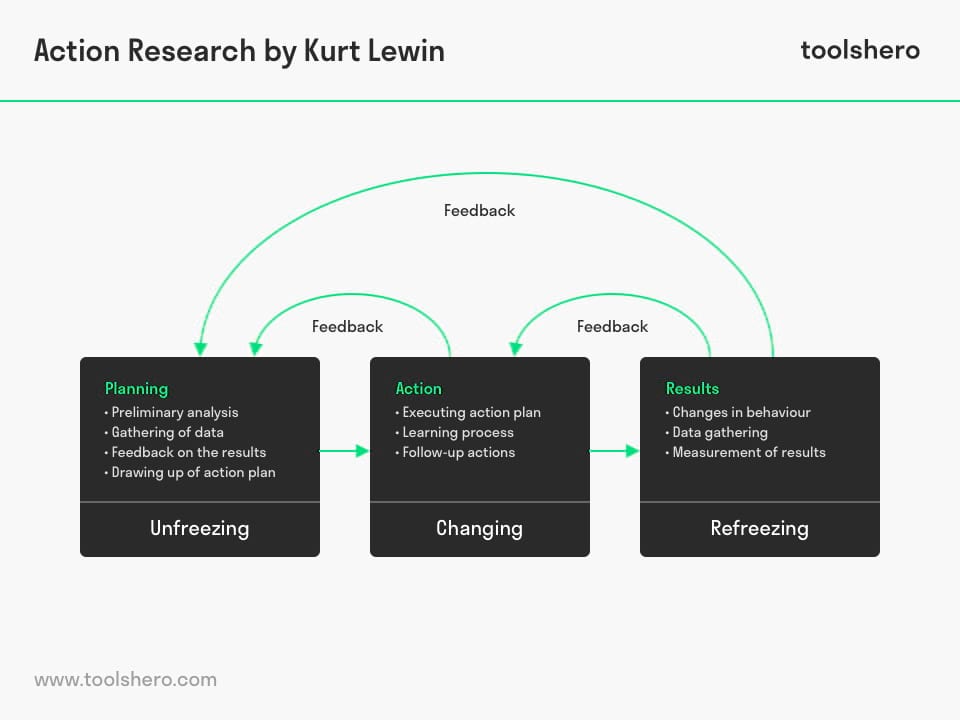Action Research model (Lewin)

Action Research model: this article explains the concept of Action Research (AR), developed by Kurt Lewin in a practical way. It covers what AR is, what steps should be taken, based on the model and example and what conditions should be met. After reading you will understand the basics of this research method. Enjoy reading!
Background of Action Research theory
The German-American professor Kurt Lewin was mainly concerned with child psychology.
He became known for his contributions to “Gestalt psychology” and in 1951 he carried out ground breaking research into the way in which human behaviour could be changed towards democratic values and leadership. This is why he is considered to be the founder of Action Research.
What is the Action Research model? The theory
Kurt Lewin ’s approach of Action Research is a research method in which the researcher intervenes in and during the research. This serves two purposes: firstly, according to Kurt Lewin, it will bring about positive change and secondly, knowledge and theory will be generated.
It is important that the researcher acts as a social change expert who helps and encourages employees to change their behaviour towards democratic values and leadership. A cooperation between fundamental and applied research is essential in this.
According to Lewin scientific research is best achieved through cooperation between the researcher (academic) and the people in the work field (practitioners).
The definition of Action Research
The term was first suggested by Kurt Lewin. He described the practice as ‘a comparative research on the conditions and effects of various forms of social action and research leading to social action’ that uses ‘a spiral of steps, each of which is composed of a circle of planning, action and fact-finding about the result of the action’.
Participatory action research in education
AR is also called Participatory Action Research (PAR). This concerns an individual method of this research method. Other working methods are community-based participatory research and school-wide action research.
Other names for the methodology are action cycle or research cycle. In education, action research refers to various evaluative, investigative, and analytical research methods, which are especially designed to study organizational, academic or educational problems or deficiencies.
In addition, these methods help teachers to develop practical solutions to address the aforementioned problems.
Action Research model and steps, an example of education
It is referred to as a cycle because the method usually consists of a predefined process that is repeated over time. Below is an action research example of what the cycle might look like. The model is aimed at education.

Figure 1 – the steps of action research example in education
1. Selecting focus
The AR-process starts with a reflective action aimed at discerning one or more topics worthy of the teacher’s or researcher’s time. Since different actions and teachers in the classroom are in high demand, all activities should be worthwhile for the researcher.
Therefore, focus selection is considered the first step in the action research process. Focus selection begins with the researcher or team asking questions about which elements of the research benefit practice or learning.
2. Clarifying and establishing theory
The next stage in the AR process is to identify and discern the values, beliefs and theoretical perspectives the researchers have about the focus they have chosen in the first step.
When researchers or teachers are concerned about a particular development in the classroom, it is helpful to first clarify which approach or method would work best. For example, should the teacher set up a reward system? Or should the students experience the consequences of their behavior in a natural way?
3. Identifying research questions
Now that the selection of focus areas has been completed and the perspectives of the researchers or lecturers have been clarified, the next step is to generate research questions that are intended to shape the research.
4. Collecting data
Accurate data and information is important because everyone bases decisions on it. This is also the case for researchers or teachers. Action researchers ensure that the data used to base decisions on is reliable and valid at the same time. Valid in this context means that the information accurately represents and conveys the researchers’ message.
Typically, researchers ensure that they get their information from multiple data sources. Many of them use triangulation. This is a process to increase the reliability and validity of data.
Triangulation is explained as studying or observing an object or information by looking at it from multiple perspectives. This helps a researcher to compare things and look at a topic from multiple angles.
Data collection is one of the trickiest parts of the action research process.
5. Analyzing data
Data analysis usually refers to complex statistical calculations and relationships. However, this is not always the case for teachers and researchers. There are easy-to-use procedures and best practices that help the user identify patterns and trends in the data.
6. Reporting
Although it may sound contradictory, many teachers consider their profession to be lonely. Many teachers spend every day teaching others, designing lessons and doing this on their own. Reporting action research is therefore very important. This usually takes place in an informal setting, unlike the formal setting where scientific research is shared.
7. Action planning
Action planning is also referred to as informed action. This is the final step in the research method process. When a teacher or researcher writes a plan or develops a program, he or she is usually also involved in the planning process. Action planning is more of an approach than a method.
It is a statement of what someone wants to achieve in a certain period of time. Drawing up and executing an action plan is an effective way to achieve goals.
Examples of AR
Different tools are used to support AR, depending on the working method and the problem to be studied. Examples of these methods are:
- Observation of groups or individuals;
- By means of audio and video recordings;
- Through interviews;
- Monitoring and taking notes;
- By means of photos or questionnaires.
Action Research and Intervention
Besides the research of social systems, Action Research is all about solving problems in order to bring about social change. During the research method, the researcher does not merely observe and interpret information but he is also an active participant in the process.
This allows him to intervene faster and better and bring about change. One major advantage is that he will have a better understanding of the problems. Close cooperation with the field will increase the perceptions of the researcher and the practitioners. During research method the focus can be centred on the activities or the research itself.
Conditions for Action Research
For this research method to be successful, Kurt Lewin established a number of conditions must meet:
- the research must be problem-oriented
- the employee (client) must be at the centre
- the current situation (status quo) must be included in the discussion
- the research must produce empirically demonstrable propositions (direct and indirect observations)
- propositions and findings must systematically fit into a useful theory.
Cyclical approach
Changes in accordance with the Action Research approach have the nature of an exception, in which stability (Freeze) is the standard, change the deviation from that standard and behaviour modification (Unfreezing) a response.
This research method is a cyclical process of change and is connected in his change model. During the Unfreezing stage a period of problem awareness takes places (Planning), during the change stage new forms of behaviour are tested (Action) and during the refreezing stage this new behaviour is reinforced and will become a habit over time (Results).
Action Research in practice
Action Research is a form of collective self-reflective enquiry, undertaken by participants in social situations such as employees within an organization.
Because of the research they are able to analyze and improve their own social and/ or educational skills. Research that produces nothing but books will not suffice according to Kurt Lewin.
It is about practice and a goal-oriented approach in which planning, action and fact-finding lead to good and satisfactory results and to understanding among the participants.
It’s Your Turn
What do you think? Do you conduct Action research? If so, what are your experiences? If not, which new insights did you get by reading this post? What are in your opinion success factors for conducting Action research?
Share your experience and knowledge in the comments box below.
More information
- Coghlan, D. &amo; Brannick, T. (2014). Doing Action Research in Your Own Organization. Sage Publications Ltd.
- Dickens, L., & Watkins, K. (1999). Action research: rethinking Lewin. Management Learning, 30(2), 127-140.
- Lewin, K., & Gold, M. E. (1999). Group decision and social change.
- Lewin, K. (1946). Action research and minority problems, in: G.W. Lewin (Ed) (1948) Resolving Social conflict. Harper & Row.
How to cite this article:
Van Vliet, V. (2021). Action Research model (Lewin). Retrieved [insert date] from Toolshero: https://www.toolshero.com/change-management/action-research/
Original publication date: 03/14/2021 | Last update: 08/21/2023
Add a link to this page on your website:
<a href=”https://www.toolshero.com/change-management/action-research/”>Toolshero: Action Research model (Lewin)</a>












